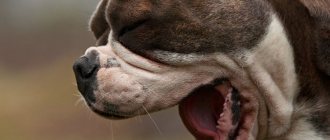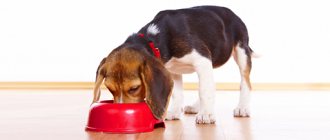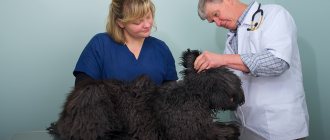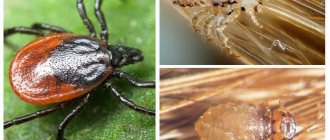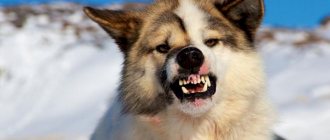There is no particular oddity in the fact that the animal pays special attention to its tail. Little puppies pay active attention to their tail in the process of learning about their body. If the animal begins to bite its tail too often, without stopping, until wounds and blood appear, it is necessary to pay attention to this.
The reason for this manifestation may be serious disturbances in the functioning of the body. It is recommended to show the animal to a veterinarian. The doctor will conduct a number of necessary studies and provide adequate assistance.
Causes
If a dog chews its tail, it can be caused by three main groups of reasons:
- Itching (which, in turn, can be physiological and pathological).
- Neurosis.
- Psychological reasons.
Physiological itching
It is caused by completely ordinary reasons, and there is no illness behind it.
Most often this happens when the dog's tail is dirty with something. She feels discomfort and tries to cleanse herself. Or simply itches, slightly biting the tail.
In this case, this does not last long and the dog behaves calmly. If during the day you notice that your pet is constantly biting or even gnawing on its tail, but there are no foreign objects or dirt in the fur. This is a warning sign. We need to find out the reason.
Pathological itching
Caused by disorders in the body or invasion. Your dog may have itchy skin at the base of his tail, the tail itself, or the area around the anus.
Because of this, the dog is constantly in an excited state and feels severe discomfort and can gnaw its tail even until it bleeds. The most common pathologies that cause this symptom:
Skin parasites.
It could be fleas or ticks. Remember that fleas do not live on animals, they only feed on them. Therefore, sometimes you may not even see parasites, but they will bother your pet.
Ticks.
As a rule, when a dog is bitten by an Ixodid tick, it does not feel it, so it is unlikely that such a reaction will occur to a regular tick.
But if you remove a tick from your pet, carefully monitor its condition! There is a possibility of piroplasmosis!
But if the dog is overcome by scabies mites, then severe itching is guaranteed. And you won’t be able to see them with the naked eye either.
On the tail itself, skin parasites have nothing to do; they will rather be localized on the skin near it. And from the outside we will see that the dog is furiously gnawing the root of its tail.
Internal parasites (worms).
Those helminths that are localized in the intestines can cause itching in the rectum. This usually occurs with severe infestation. The itching spreads to the anus, the dog experiences discomfort, does not understand what is happening and may begin to chew its tail, trying to get rid of the itching sensation.
Inflamed paraanal glands.
Under normal conditions, the paraanal glands do not bother our four-legged friends. They are located on the sides of the anus, normally they are not noticeable, and they self-clean during the act of defecation.
In some cases, they can become clogged and inflamed, this is especially common among small dog breeds.
In such cases, the pet experiences severe discomfort and itching. To get rid of it, he may start biting or even gnawing at the base of the tail.
Dermatological diseases.
Skin diseases can have different origins. They can be caused by fungi, bacteria, and parasites. But regardless of origin, they are almost always accompanied by itching. To suspect a dermatological problem, it is enough to examine your pet and see obvious skin lesions. But this is not enough to help the pet.
There are many diseases, so you should always contact a veterinary dermatologist to make an accurate diagnosis.
Allergy.
Allergies can be triggered by food and flowers, as well as household chemicals. Allergies quite often manifest as excessive dry skin, redness and severe itching. Sometimes only the last one. You can often see a dog chewing its tail and paws.
Injuries.
Tail fractures are more common in practice than it seems. And this behavior of the dog only worsens the situation. The dog is experiencing pain in its tail and wants to get rid of this pain. Sometimes she gets angry at her own tail because it causes discomfort.
In this case, you may see the dog chewing its tail and whining as it does so. You can’t leave everything as it is; be sure to take your pet to the veterinarian; part of the tail may have to be amputated.
Neuroses
Neurotic disorders are a very complex topic. They are associated with inhibition or overexcitation of the nervous system, disorders of the conduction of nerve impulses.
These pathologies manifest themselves in different ways, depending on the cause, stage and nature of the disorder.
Such disturbances may be accompanied by changes in behavior. Just one example is the phenomenon when a dog angrily gnaws its tail until it bleeds.
This condition is dangerous both for the animal itself and for everyone around it.
As a rule, this condition has prerequisites:
- inhibition of normal reactions;
- on the contrary, overexcitation;
- unusual reaction to stimuli;
- the animal is in constant fear and tension.
The causes of neurosis can be:
- prolonged exposure to severe stress;
- exhaustion;
- severe overloads;
- intoxication and some infectious diseases.
Neurosis is a very serious disease. Tail biting is usually a symptom of the onset of the disease. That's why you shouldn't turn a blind eye to it. It is better to contact a veterinarian in a timely manner.
Psychological reasons
Neurosis and psychological disorders are different things. In neurosis, there is already damage to the nerves or cerebral cortex. With psychological disorders there is no direct damage.
Some dogs are prone to stress, and often it manifests itself in this very behavior - the dog begins to chew. It could be foreign objects, or maybe his own tail.
Stress in dogs can be caused by:
- moving;
- severe fear;
- long absence of the owner, boredom;
- resentment towards the owner;
- climate change.
Sometimes a psychological disorder may only manifest itself as a dog chewing its tail, without other changes in behavior.
Possible health problems
The most common assumptions that arise when you see a dog itching or gnawing on something on its skin are allergies or fleas. But besides this, there are a number of other dermatological diseases that can cause a dog to need to bite and even gnaw its tail until it bleeds:
- Worms cause itching in the anal area. In attempts to get rid of it, the animal constantly bites the base of its tail. You can also notice how the pet tries to scratch the anus on the ground.
- Skin mites and fleas cause a lot of discomfort to the dog. The activity of parasites that live on the skin causes severe itching. Trying to calm him down, the dog scratches and bites not only the tail, but also other parts of the body.
- Skin diseases of various etiologies: fungal, bacterial, allergic, also cause pain and make the dog want to bite and scratch itself. Additional symptoms include rash, scaly patches on the skin, hair loss, and fever.
- An allergy to any food components, household items, or chemicals manifests itself as skin irritation, itching, and diarrhea.
- Inflammation of the paraanal glands in a dog also leads to the fact that it tries to scratch or chew its tail intensely. This problem is caused by the pet’s insufficient physical activity and the habit of restraining the natural urge to urinate in an apartment.
- If your pet starts biting its tail, it may be injured. In this case, the animal tries to cause discomfort by biting, which will dull the pain.
- Insufficient care of your pet and untimely hygiene can lead to dirty fur becoming tangled into lumps and thorns or burrs getting stuck in it, causing trouble.
Diagnostics
To help your pet, you need to understand what exactly you are faced with.
- If the dog just sometimes plays with his tail and is easily distracted from this activity, then everything is fine.
- If a dog obsessively chews its tail, then the reason is clearly pathological.
- When this is caused by parasites, the pet will most likely bite the base of the tail. You may not notice fleas, but you definitely won’t see ticks. The diagnosis will be made at the veterinary clinic after a scraping is taken. Intestinal parasites can also be recognized by the appearance of the pet - with increased appetite, it can noticeably lose weight. But a veterinarian will be able to confirm your guesses after taking a smear for analysis.
- If this is due to an allergy, then severe itching spreads throughout the body, but this can especially be noticed by the fact that the dog chews its tail and paws. There may be no other symptoms other than itching. But redness of the skin is also common.
- In cases where the tail is injured, the dog may bite it and whine, or even yelp, at the same time. Injury can only be confirmed using x-rays.
- Another kind of reason is neurosis. In this case, aggression is added to the strange games with the tail. The dog chews its tail until it bleeds and growls. Be sure to go to the clinic.
- Psychological causes are due to stress or boredom. Prolonged stress can lead to neurosis, so it is better to avoid this.
- In any of these cases, the help of a specialist is required.
Why does a dog bite its tail and spin around?
Aggressive tail biting and walking in circles are characteristic of neuroses - obsessive states accompanied by the performance of monotonous actions. The most common of them include the following:
- Ataxia. Develops with damage to the cerebellum. Causes complete or partial loss of mobility and orientation in space. The dog falls out of the blue and does not always successfully climb onto vertical surfaces, which seriously affects the quality of life.
- Catching Tail Syndrome. It is not an independent disease and is a combination of certain symptoms. The animal can run in a circle for 15 minutes in a row and return to this activity again after a short rest.
In addition to running in circles, obsessive states include monotonous licking of paws, catching invisible fleas and walking from corner to corner. Existing disorders increase excitability and aggression, which affects the pet’s habitual behavior. Despite the lack of specific treatment, it is possible to reduce the frequency of obsessive-compulsive disorders to a minimum.
Treatment
If the pet is stressed or doesn’t get enough exercise and is constantly bored, the owner will have to work on this. It is necessary to establish a relationship with your four-legged friend, since the connection with the owner is very important for the dog, for them the person is the basis of safety.
You may have to seek help from a dog handler or animal psychologist. In all other cases, treatment should be prescribed by a veterinarian.
To prevent your pet from chewing its tail until it bleeds, put a special collar on it.
Game element
The most harmless reason for biting your tail is when your pet is trying to entertain itself. A puppy who finds himself in an apartment without his friends may get bored. He does not yet perceive the tail as part of the body and takes it for a moving toy that is interesting to catch.
If an adult pet is seen doing such an activity, perhaps the dog lacks communication with the owner and his affection. In an attempt to attract attention, she may, for example, bite her own tail instead of furniture.
If such behavior is not intrusive in nature, the animal is easily distracted from such an activity and switches to playing with its owners, then there is no reason to worry.
Popular questions
Is it possible to stop a dog from chasing its tail?
It is possible and necessary. This behavior is not entirely normal for an adult dog, even if it is just a game. She should have other entertainment so she doesn't get bored. You may have to contact a dog handler for help.
A dog chews its tail while eating - what to do?
It is necessary to contact a veterinary clinic for diagnosis. It may be due to an unbalanced diet. There may be a neurotic cause; the problem cannot be left unattended.
Why does a dog chew the scar from a docked tail?
The reason for this may be the items described in the article, from stress to allergies.
A special collar will help stop the dog from this action. But the reason needs to be found out; additional research may be needed.
What to do if your dog is chewing its tail
In case of slight distraction from chasing the tail, it is recommended to engage in training and education, and in case of obsessive states, drug or surgical treatment. In the latter case, the algorithm of actions will depend on the diagnosis.
Training and education
Regular training and proper education help control unwanted behavior. These include:
- Teaching outdoor games. This method is suitable for hyperactive breeds with a developed hunting instinct. In addition to running, playing with a ball and Frisbee, dog trainers recommend signing up for agility or any other kind of dog training sport that is suitable for you.
- Activities aimed at suppressing feelings of loneliness. If your pet is sad alone and doesn’t know what to do with himself, buy him more interactive toys that he can play with without a partner.
- Remembering basic commands. When unwanted actions are performed, the animal's attention can easily be switched to performing commands or tricks.
The duration of training is individual. It can take just a couple of weeks - or more than a month. It is very important to be patient and not rush things. If a series of successes gives way to failure, don’t give up and just go back a few steps. Sooner or later, regularity and positive motivation (praise and tasty reinforcement) will definitely give results.
Treatment under the supervision of a veterinarian
Parasitosis is treated with acaricidal drugs, and inflammation of the paraanal glands is treated with rectal suppositories and antibiotics. The blockage itself is removed manually, using washing or anal sacculectomy, that is, removal of the glands.
Lifelong use of antihistamines may be required to suppress the allergic reaction, and a short course of antifungal therapy may be required to eradicate the lichen. The method of treating eczema depends on its type. Wet ones are treated with antibiotics, and dry ones are treated with glucocorticosteroids and antihistamines. In case of frequent endocrine disorders, the animal is sterilized.
The consequences of injuries to the caudal region are eliminated by amputation or suturing, and psychological disorders are eliminated by preventing provoking factors and taking sedatives. During treatment, a special collar is put on the pet, which prevents the appearance of new scratches and other damage to the skin.
Briefly about the main thing
- A dog may bite its tail simply while playing, but this is more common in puppies. Or when the tail is simply dirty with something and the dog is trying to clean itself.
- Pathological reasons for biting one's tail are itching caused by various pathologies. Psychological disorders (boredom or stress). Neuroses (nervous and mental disorders).
- You can guess the reason for this behavior in a dog at home by examining and observing it. But the diagnosis must be established in a veterinary clinic.
- If your dog is chewing its tail, you should not turn a blind eye to it. This behavior may be a symptom of a serious pathology.
- It is impossible to protect your pet from all diseases, but you can reduce the dangers. Don't forget about annual vaccinations and periodic treatments against parasites.
- You need to take care of the dog, give it the necessary exercise and be on “good terms” with it.
Did you like the article? Share it with your friends on social media. networks. This will help them get useful information and support our project.
Psychological factors of obsessive-compulsive disorder
The reasons that a dog pays too much attention to its tail may be psychological. Stress and related obsessive states can be triggered by various factors:
- change of owner or aggression on his part;
- severe fear of the dog, its resentment;
- moving to a new place of residence;
- jealousy after the appearance of another pet in the house;
- too intense training, which causes exhaustion of the nervous system;
- noise from household electrical appliances or New Year's fireworks.
Establishing a trusting relationship between the owner and the dog and restoring its nervous system require time and consultation with a specialist.
The positive impact of competent training has been noted, during which the dog learns to control its behavior. For example, special games can satisfy your pet's hunting instinct. Developing fetch skills in a dog, toys like Frisbees will captivate the dog and have a beneficial effect on his mental state.
Veterinary examination
It is necessary in order to exclude any pathologies in the body. A full veterinary examination is not very cheap. But it allows you to understand the state of your pet’s health.
If it has been noticed that the dog is losing weight for no good reason, a full diagnosis needs to be carried out. Only in this case will it be possible to understand the situation. Without an examination, nothing can be determined. Old animals lose weight, despite proper care and timely intake of special supplements. Dogs are very sensitive to various changes in their health. The more attention they receive, the better.
The dependence of this behavior on the breed
Is there a connection between a dog's desire to chase its tail and bite it with breed? Partially yes. It's no secret that dogs of one breed can be calmer than others. The calmer the animal, the lower the likelihood of this behavior.
It is important to understand that all dogs are susceptible to disease to a certain extent, regardless of their breed. So there is no difference here. For example, German Shepherds and Japanese Spitz are equally affected. In any case, you will have to find the reason for this behavior and eliminate it, since the proper health and mood of your four-legged friend depends on this.
Age, pregnancy or nursing
Some owners may not pay attention to this problem, explaining everything, for example, by the age of the animal. Or they dump everything on pregnancy or feeding puppies.
This problem cannot be related to the age of the animal. Pregnancy and feeding are also not reasons for gnawing.
Older dogs may experience hair loss. And lactating bitches may experience ritualism due to feeding puppies. But it has other manifestations
. The degree of gnawing can be affected by the animal's temperament.
If the cause is fleas, then you need to take the following measures:
:
- Bathe using special shampoo.
Important!
The shampoo should have a flea-killing effect.
- Treat with anti-flea drops.
- Wear a collar to prevent fleas.
If there are a lot of fleas, it is advisable to treat the home
. You can use special aerosols. It is necessary to treat all surfaces in the house, carpets, and upholstered furniture as thoroughly as possible. It is also recommended to wash the floors and spray the threshold of the front door with the same product.
All this can be purchased at any pet store.
. If you do all of the above, then you will forget about such a problem as fleas for a long time.
Allergy
In the case where the cause is an allergy, you first need to find out what exactly it is. When suspicion falls on the dog's food, shampoo or new bedding, try changing the diet, bath or bed. If there is no improvement, then we look for another reason.
An allergy can be easily diagnosed if fur comes out after changing one of the above.
To eliminate symptoms, taking antihistamines is also necessary. The banal “Diazolin”
at the rate of one tablet per 10 kilograms of weight.
In some cases, it may be necessary to take hormonal medications, but only a veterinarian can prescribe them correctly.
Inflammation of the glands
If the cause is inflammation of the paraanal glands, you need to clean them, you can do this yourself, but for the first time it is recommended to consult a specialist
.
The resulting wounds at the site of gnawing can be treated with chlorhexidine.
Stress
In case of stress, the cause must be found and eliminated. Create favorable conditions for the dog's life.
If you have the opportunity to use the help of a veterinarian, it is better to contact a special hospital immediately after the problem appears.
. As mentioned above, you may need to take additional medications, and it is not recommended to prescribe them yourself.
When to worry
If tail hunting occurs periodically, it is not particularly of concern to the dog owner. You should worry when the situation becomes protracted. Running in circles for a long time indicates an unstable mental state.
This behavior of a pet can unbalance the vestibular apparatus, which will worsen the general condition of the animal. Obsessive manifestations also lead to physical exhaustion.
When a pet continually and violently pulls at its appendage, it often ends in serious injury. As a result, the entire tail has to be amputated.
It is difficult to control such a situation: the owner cannot pay attention to the dog 24 hours a day. Therefore, prohibitions here are not effective, but will make the relationship with your pet strained.
Sedatives and antidepressants will help cope with psychological problems. Special training, games and meaningful walks will distract your dog from obsessive behavior.
It is recommended to switch your pet's attention from chasing the tail to the implementation of natural instincts. Fetching, playing with a frisbee, hunting or playfully chasing a mechanical hare would be appropriate here.
Hot Spots
A hot spot is an area on a dog's body where repeated scratching or chewing results in an open wound. Warmth and humidity are optimal conditions for hot spots to form. If stray bacteria enter the site of infection before it has been properly treated, a secondary infection is the typical result. Identify the hot spot by blood, pus, and matted hair.
If your puppy or dog scratches its tail so often that it bleeds, then secondary infections are not the root cause of its problem, but just another symptom. Your veterinarian can help you determine whether the actual cause is related to hygiene, nutrition, or another factor.
Help your pet
It happens that diagnosis takes a long time, and debilitating itching and continuous self-scratching only aggravate the dog’s condition. Apoquel will help relieve symptoms during this time. It successfully relieves itching, and does not harm the body in any way. A huge advantage of Apoquel is that it can be used for a long time without any harm to the dog. This drug has no analogues. Apoquel is an absolute innovation in the world of veterinary dermatology. It relieves itching at the cellular level, beginning to act within 4 hours after giving the tablet. Apoquel is suitable both for allergies to flea saliva and will provide a comfortable life for an animal with atopic dermatitis.
Consult your veterinarian before use.
Lacerated anal glands
Finally, another common reason why a dog scratches its tail until it bleeds is a diseased anal gland. And a dog's anal glands are important for a dog. Just like we shake hands when we meet people, canine anal glands secrete interesting fluids that dogs sniff when they meet each other. This is one of the reasons why dogs are so eager to sniff each other whenever possible.
One obvious sign that a dog has anal gland problems is when he runs away, sitting down and dragging his butt on the ground. Other symptoms include a foul-smelling dog's back than usual, trouble defecating (you call it constipation), and, in severe cases, blood or pus in the feces.
Symptoms that should prompt you to visit the veterinarian
If serious symptoms appear, you should immediately consult a doctor to eliminate a threat to your pet’s health. These symptoms include:
- impaired coordination of movements;
- involuntary clicking of the jaw;
- active licking of fur, as well as gnawing it;
- the dog begins to actively itch;
- eating feces;
- uncontrolled and causeless aggression;
- the dog begins to bark or take out its anger on other animals.
If symptoms of the disease are detected, it is important to immediately show your pet to a specialist.
Injury
Any type of injury to the back or rear of the limbs - such as a broken tailbone - is something that a dog cannot communicate to its owner and may go undetected under normal circumstances. The intensity of a dog's pain may prompt him to act out or draw attention to it by excessively scratching his tail or other injured area. Only a veterinary x-ray will be able to correctly diagnose such a problem.
© shutterstock

